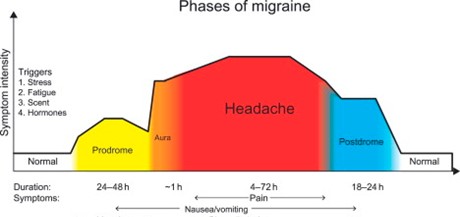
Migraine
A migraine can be described as having severe throbbing or pulsatile headache (usually on one side of the head). It can be accompanied by nausea, vomiting and sensitivity to bright light or loud sounds. Each migraine attack can last for between hours to days and the severity can vary between being mild or extremely severe where the person has to lie down and rest. Prior to the onset of a migraine, there may be a warning sign known as ‘an aura’ which can be;
- visual disturbances (such as flashes of light or visual disturbances)
- tingling sensation of 1 side of the face
- difficulty speaking
- smell disturbance (such as have an unusual strange smell)
Click to view WebMD video on Migraine
Trigger factors
Migraines usually start at adolescence and peaks at around 25-30 years of age. There may also be a family history. These are some common factors which can trigger a migraine attack;
- Hormonal changes in women during periods
- Medications such as oral contraceptives can aggravate migraines
- Physical or psychological stress
- Poor sleep habits or insufficient sleep
- Drinks such as alcohol or caffeine
- Weather changes (such as from hot to cold and vice versa)
- Food such as chocolate, cheese or food additives
- Excessive sensory stimuli such as bright lights, loud sounds or strong smells such as smoke or perfume

Phases of Migraine
Migraines can progress through 4 phases namely; prodrome, aura, attack and post-drome although not all migraines necessarily goes through all 4 phases. The migraine attack can stop at any phase and the duration may also vary.
Prodrome
Prior (around 1-24 hours before) to a migraine, there may be subtle changes such as:
- Mood changes
- Food cravings
- Neck stiffness
- Frequent yawning
Aura
Aura usually occurs just before or during migraines and consists of visual or auditory sensations such as flashing lights or tinnitus sounds. Other symptoms include pins & needles, difficulty with speech, weakness on 1 side of the body (similar to a stroke)
Headache (main attack) Phase
During the migraine, the headache is usually;
- On one side of the head
- Throbbing or pulsating in nature
- Made worse to light, sound or even strong smells
- Accompanied by nausea and vomiting
Post-drome
After a migraine attack, the person usually feels disorientated and tired out. This may last from 1 few hours to 1-2 days and patients may need to rest in a quiet environment to recover.
Treatment
It is important to see a doctor to have a complete assessment of the symptoms and assess the frequency & severity of the migraine attacks. A brain tumour or lesion such as AV malformation, aneurysm, stroke or brain haemorrhage may give similar symptoms of headaches as well. These headache symptoms have slight differences such as;
- Sudden onset of severe headache (or different in nature compared to the usual headache)
- Headache with stiff neck, fever, weakness, numbness or slurred speech
- Headache which is NOT relieved or made worse by lying down
- Headache which is aggravated by coughing or straining
Although there is currently NO cure for migraines, there are a number of treatment options available to help provide relief for the symptoms.
- Avoidance of trigger factors
- Medication for prevention of migraine
- Medication for pain relief
- Acupuncture
- Relaxation techniques
The goal of successful treatment is to reduce the frequency and severity of each migraine attack using the strategy above and using as little medication as possible.

Migraine Diary
It is useful to keep a diary of your migraine attacks over a period of time to help your doctor or Healthcare Provider to devise a treatment plan. Write down the following details such as;
- the date & time of each attack
- duration of the attack
- severity of the headache (scale of 1-10)
- what were the trigger factors
- what were you were doing when the migraine began
- what were the symptoms
- what medicines helped to provide relief
Discuss with your Doctor, the treatment options available for you
Disclaimer. TELEME blog posts contains general information about health conditions and treatments. It is not intended to be a substitute for professional medical advice, diagnosis or treatment. The information is not advice and should not be treated as such.
If you think you may be suffering from any medical condition, you should seek immediate medical attention from your doctor or other professional healthcare providers. You should never delay seeking medical advice, disregard medical advice, or discontinue medical treatment because of information on this website.








